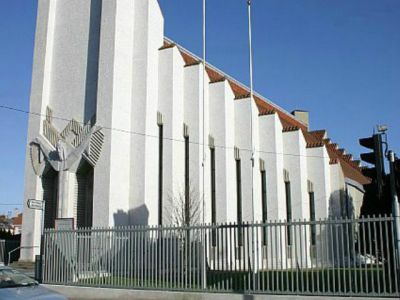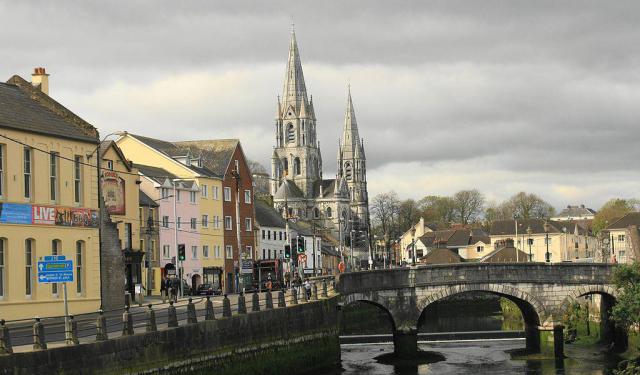Church of Christ the King, Cork
The Church of Christ the King in Cork City is a remarkable architectural achievement and an important historical landmark. It was designed by the American architect Barry Byrne, making it the first church in Ireland to be designed by a foreign architect. The church was built between 1929 and 1931 by John Buckley and was opened on the Feast of Christ the King on Sunday, 25th October 1931.
One of the most notable features of the church is its construction. Unlike traditional churches, which were built from brick or stone, the Church of Christ the King was constructed entirely from concrete. This made it not only unique for its time but also one of the largest suspended-ceiling churches in Europe. The church has a seating capacity of 1,200 people, and its interior is both spacious and awe-inspiring.
Another interesting aspect of the Church of Christ the King is its museum, which contains numerous artifacts of historical significance. The museum offers visitors a glimpse into the rich history of the church and the community it serves.
One of the most notable features of the Church of Christ the King is the large sculpture of Christ the King by John Maguire, which is situated above the entrance. This work of public art is a landmark and adds to the church's visual impact. The architect, Francis Barry Byrne, was strongly influenced by Frank Lloyd Wright, and this influence can be seen in the church's design.
The church's construction and design were commissioned by Bishop Daniel Cohalan of Cork in 1927. At that time, the Feast of Christ the King was a recent addition to the Church's calendar, having been introduced by Pope Pius XI in 1925. The Pope's encyclical, Quas Primas, emphasised the importance of recognising Christ as King and the need for the Church to teach this doctrine.
Today, the Feast of Christ the King is celebrated by many Christian denominations, including Anglicans, Lutherans, Methodists and others, through the Revised Common Lectionary. The Church of Christ the King continues to be an important religious and cultural landmark in Cork City, and its unique design and history make it a must-see for visitors to the area.
One of the most notable features of the church is its construction. Unlike traditional churches, which were built from brick or stone, the Church of Christ the King was constructed entirely from concrete. This made it not only unique for its time but also one of the largest suspended-ceiling churches in Europe. The church has a seating capacity of 1,200 people, and its interior is both spacious and awe-inspiring.
Another interesting aspect of the Church of Christ the King is its museum, which contains numerous artifacts of historical significance. The museum offers visitors a glimpse into the rich history of the church and the community it serves.
One of the most notable features of the Church of Christ the King is the large sculpture of Christ the King by John Maguire, which is situated above the entrance. This work of public art is a landmark and adds to the church's visual impact. The architect, Francis Barry Byrne, was strongly influenced by Frank Lloyd Wright, and this influence can be seen in the church's design.
The church's construction and design were commissioned by Bishop Daniel Cohalan of Cork in 1927. At that time, the Feast of Christ the King was a recent addition to the Church's calendar, having been introduced by Pope Pius XI in 1925. The Pope's encyclical, Quas Primas, emphasised the importance of recognising Christ as King and the need for the Church to teach this doctrine.
Today, the Feast of Christ the King is celebrated by many Christian denominations, including Anglicans, Lutherans, Methodists and others, through the Revised Common Lectionary. The Church of Christ the King continues to be an important religious and cultural landmark in Cork City, and its unique design and history make it a must-see for visitors to the area.
Want to visit this sight? Check out these Self-Guided Walking Tours in Cork. Alternatively, you can download the mobile app "GPSmyCity: Walks in 1K+ Cities" from Apple App Store or Google Play Store. The app turns your mobile device to a personal tour guide and it works offline, so no data plan is needed when traveling abroad.
Church of Christ the King on Map
Sight Name: Church of Christ the King
Sight Location: Cork, Ireland (See walking tours in Cork)
Sight Type: Religious
Sight Location: Cork, Ireland (See walking tours in Cork)
Sight Type: Religious
Walking Tours in Cork, Ireland
Create Your Own Walk in Cork
Creating your own self-guided walk in Cork is easy and fun. Choose the city attractions that you want to see and a walk route map will be created just for you. You can even set your hotel as the start point of the walk.
Cork Introduction Walking Tour
Cork’s story starts in the 6th century, when Saint Finn Barr decided that a patch of soggy ground was the perfect place for a monastery. The swampiness of the place was immortalized in its original Irish name Corcaigh or corcach, meaning “marsh”. It was a quiet, devout little community… until the Vikings showed up between 915 and 922. They parked their longships, set up a trading port, and... view more
Tour Duration: 2 Hour(s)
Travel Distance: 4.0 Km or 2.5 Miles
Tour Duration: 2 Hour(s)
Travel Distance: 4.0 Km or 2.5 Miles
Cork Heritage Pub Trail
A truly fun way to explore Cork is by visiting the local heritage pubs, a cherished part of the city's cultural and social fabric. Situated in the heart of Cork, these establishments are not just places to grab a drink but living time capsules that take you back to a bygone era in a warm and welcoming setting. Let's take a look at some of Cork's notable “watering holes”.
Sin... view more
Tour Duration: 1 Hour(s)
Travel Distance: 2.1 Km or 1.3 Miles
Sin... view more
Tour Duration: 1 Hour(s)
Travel Distance: 2.1 Km or 1.3 Miles





